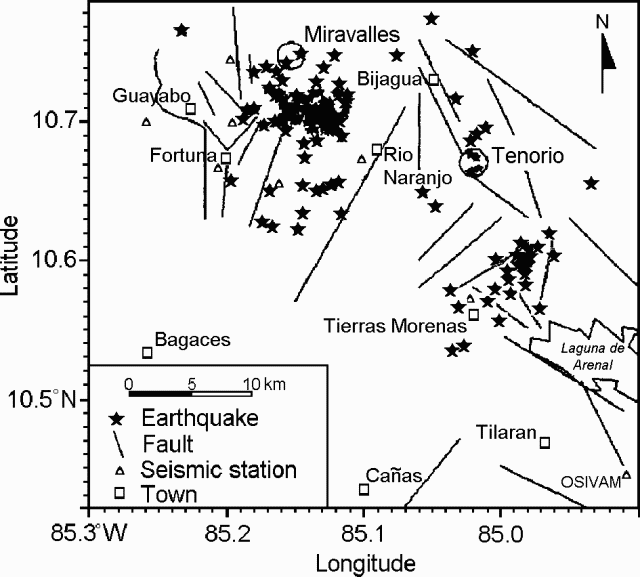Report on Miravalles (Costa Rica) — October 1997
Bulletin of the Global Volcanism Network, vol. 22, no. 10 (October 1997)
Managing Editor: Richard Wunderman.
Miravalles (Costa Rica) Significant earthquake swarm under S flank
Please cite this report as:
Global Volcanism Program, 1997. Report on Miravalles (Costa Rica) (Wunderman, R., ed.). Bulletin of the Global Volcanism Network, 22:10. Smithsonian Institution. https://doi.org/10.5479/si.GVP.BGVN199710-345030
Miravalles
Costa Rica
10.748°N, 85.153°W; summit elev. 2028 m
All times are local (unless otherwise noted)
The most significant earthquake swarm at Miravalles in several years occurred on the S flank during 5-27 October (figure 2). The swarm, consisting of 146 located events, was centered around 10.7°N, 85.15°W. No pattern was found correlating the seismity with known local faults.
Approximately 88% of the earthquakes were M5.0 are not rare near Miravalles; however, the occurrence of two unrelated swarms nearby at Tenorio (~16 km ESE) during October was unusual.
Geological Summary. Miravalles is an andesitic stratovolcano that is one of five post-caldera cones along a NE-trending line within the broad 15 x 20 km Guayabo (Miravalles) caldera. The caldera was formed during several major explosive eruptions that produced voluminous dacitic-rhyolitic pyroclastic flows between ~1.5 and 0.6 million years ago. Growth of post-caldera volcanoes in the eastern part of the caldera that overtopped much of the eastern and southern caldera rims was interrupted by edifice collapse which produced a major debris avalanche to the SW. Morphologically youthful lava flows cover the W and SW flanks of the post-caldera Miravalles complex, which rises above the town of Guayabo on the flat western caldera floor. A small steam explosion on the SW flank was reported in 1946. High heat flow remains, and it is the site of a large developed geothermal field.
Information Contacts: Gerardo J. Soto and Waldo Taylor, Oficina de Sismología y Vulcanología, Departamento de Geología, Instituto Costarricense de Electricidad (ICE), Apartado 10032-1000, San José, Costa Rica.


